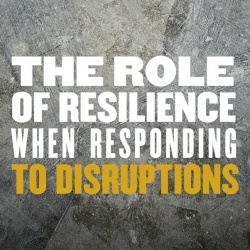 Article
Article
Hamieda Parker and Khadija Ameen. “The role of resilience capabilities in shaping how firms respond to disruptions.” 88:1 Journal of Business Research (2018): 535-541
Reviewer
Dr. Brady Brewer, Assistant Professor
Summary
Resiliency is the ability of a firm to cope with and absorb an external shock or extreme event that threatens the survival of the business. While certain business decisions like insurance can reduce the risk associated with catastrophic events. Resiliency theory is not necessarily centered on these type of mechanisms. Rather, it is focused on the firm’s ability to adapt to these disturbances and return to normal operations. These disturbances can range from weather related events where a firm faces a power outage or transportation disruption to input supply issues where a firms supplier of a key input is either unable to deliver a product or goes out of business. Both of these examples could be detrimental to a firm’s long-run trajectory.
These authors identify several key strategies that firms can undertake that will increase their resiliency:
- Disruption orientation
- Proactive risk management
- Investment in risk-averting infrastructure
- Resource reconfiguration
What this means for Food and Agribusiness
Disruptions are inevitable for a firm and the agriculture supply chain has many risks that can cause this disruption. Beyond cash flow problems associated with these risks, problems such as input supply, transportation and logistics, technological issues or something as simple as not having power can be major hurdles. Given the dependence on natural resource, agricultural firms are some of the most at-risk firms. Being able to quickly adapt to the changing landscape is vital to an agribusiness quickly and efficiently returning to a sustainable trajectory.
The first recommendation the authors suggest is for a firm to have awareness and recognition of all serious threats to the firm’s supply chain or business model which they call “disruption orientation.” This involves a thorough analysis of all points where a firm is vulnerable to external shocks that may disrupt business. The food and agribusiness supply chain are complex as products go from farm to processing to marketer to retailer. Understanding how all these interact is crucial for identifying the key risk areas for a firm.
The second recommendation the authors suggest is to formulate a proactive risk management strategy for each risk identified in the first step. The key here is the emphasis on proactive. The authors find that many firms wait for an event to happen before formulating a plan. They find that firms that have already planned for such an event are more resilient, meaning they return to normal operating faster. Managers must be forward-looking to identify methods of shielding their firm from risks.
The third recommendation is investing in risk-averting infrastructure. For weather related events, this is straightforward. Invest in infrastructure that allows you to operate through a crisis. However, for other types of supply chain disruptions, it can be more complicated. For example, if an agribusiness currently has one supplier of a particular input, it may be worthwhile to form a relationship with a secondary supplier and purchase a small number of inputs from this supplier as well. This makes switching supplier in the event the primary supplier is unable to meet their obligations much easier and reduces switching costs.
The final recommendation is resource reconfiguration. Resource reconfiguration is the capability of the firm to rearrange existing assets to meet the needs in a changing environment. Whereas previous strategies focused on one risk, this final recommendation takes a more holistic view of the firm. Sometimes individual responses, while needed, are not enough to fully recover from an external shock. In some scenarios, businesses are forced to change whole segments of their business model. This may include production practices or reshaping their segment of the supply chain. In cases where a firm has strong inertia, swiftly adapting to changes may be difficult. The authors suggest that managers practice rearranging a firm’s assets in likely scenarios so that they can better understand what their firm may look like in these situations. In a dynamic marketplace, being able to adapt the firm’s business model as quickly as possible bolsters a firm’s resilience.
To implement these strategies, the authors suggest using the Resource Based View (RBV) strategy tool. RBV is a lens through which managers can examine what the key resources a firm has and where key strategic resources exist. The authors argue that analyzing a firm’s resources in this manner helps a manager utilize specific capabilities across multiple environments which enhances strategic flexibility in times of a crisis, thus increasing resiliency.




